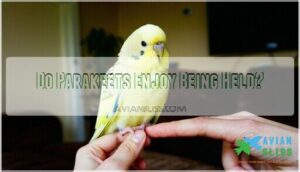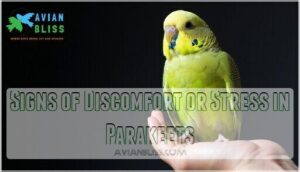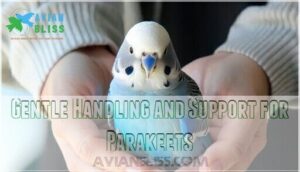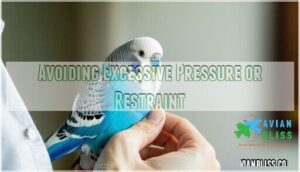This site is supported by our readers. We may earn a commission, at no cost to you, if you purchase through links.
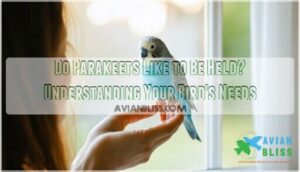
Some parakeets will never enjoy physical contact, while others become cuddly companions with patience. Watch for relaxed body language like calm breathing and soft chirping when you hold them.
Signs of stress include rapid breathing, biting, or struggling to escape. Building trust takes weeks or months of consistent, gentle interaction.
Start with short sessions and use treats to create positive associations. Understanding your parakeet’s unique personality helps you navigate their comfort boundaries effectively, which is crucial for successful interaction.
Table Of Contents
- Key Takeaways
- Parakeet Behavior and Interaction
- Do Parakeets Enjoy Being Held?
- Understanding Parakeet Body Language
- Building Trust With Your Parakeet
- Proper Techniques for Holding a Parakeet
- How to Train Your Parakeet to Enjoy Being Held
- Respecting Parakeet Preferences
- Nurturing Your Parakeet’s Well-being
- Creating a Positive Bond With Your Parakeet
- Enjoying The Unique Personality of Your Parakeet
- Frequently Asked Questions (FAQs)
- How often should I hold my parakeet?
- How can I tell if my parakeet likes being held?
- Can parakeets cuddle with their owners?
- What are some signs that my parakeet trusts me?
- How long does it take to build trust with a parakeet?
- Are there any specific techniques for holding a parakeet that I should know about?
- What age should parakeets start being held?
- How long can you safely hold parakeets?
- Do male or female parakeets prefer being held?
- Can sick parakeets be held for medication?
- Conclusion
Key Takeaways
- Your parakeet’s personality matters more than anything else – some birds naturally crave physical contact, while others prefer maintaining their personal space, and you cannot force a bird who does not enjoy being held to suddenly love it.
- Trust-building takes weeks or months of consistent, gentle interactions – you will need to start with short sessions near their cage, use treats for positive reinforcement, and let your bird set the pace for physical contact.
- Watch their body language carefully to gauge comfort levels – relaxed posture, soft chirping, and calm breathing indicate enjoyment, while rapid breathing, biting, or escape attempts signal stress and discomfort.
- Respect your bird’s boundaries and find alternative bonding methods – if your parakeet does not enjoy being held, you can still build a strong relationship through interactive games, vocal mimicry, flight training, and other activities that do not require physical restraint.
Parakeet Behavior and Interaction
Understanding your parakeet’s behavior is key to building a strong relationship with your feathered friend.
These naturally social birds have unique preferences regarding physical contact, and recognizing their individual needs will help you create the best possible bond.
Natural Behaviors of Parakeets
Since parakeets are naturally social flock birds, understanding their instinctive behaviors helps you build stronger bonds.
These intelligent creatures rely on flock instincts for security and comfort, making parakeet interaction essential for their well-being.
Key natural behaviors include:
- Vocalizations – They communicate through chirping, whistling, and talking to establish social hierarchy
- Sleep patterns – Parakeets need 10-12 hours of darkness for proper rest and health
- Dietary needs – Social eating habits mirror their wild flock feeding behaviors
Recognizing these parakeet behavior patterns improves parakeet handling success and builds parakeet trust naturally.
Bonding With Parakeets
Parakeet bonding starts with understanding your bird’s flock instincts and need for companionship.
Early socialization during the first six months creates strong foundations for trust-building with your feathered friend.
You’ll discover that positive reinforcement through treats and gentle handling encourages your parakeet to view you as part of their flock.
Building trust requires patience and consistency in your interactions.
Respect preferences by allowing your bird to set boundaries for physical contact, creating comfort through understanding rather than force.
Importance of Interaction for Parakeets
Regular interaction serves as the foundation for your parakeet’s social development and mental stimulation. Your feathered friend thrives on human interaction, which prevents loneliness and supports healthy parakeet behavior through behavioral enrichment activities.
Strengthening bonds with your parakeet requires consistent engagement that builds parakeet trust and encourages parakeet affection.
- Offer treats from your hand to create positive associations with your presence
- Talk softly to help your bird recognize your voice and feel secure
- Provide varied perching options that give your parakeet choices and control
- Watch for behavioral cues like head bobbing or chirping that signal comfort and engagement
This foundation of parakeet bonding creates the trust necessary for more intimate interactions like holding.
Do Parakeets Enjoy Being Held?
The answer to whether parakeets enjoy being held isn’t straightforward – it depends entirely on your bird’s individual personality and past experiences.
While some parakeets love snuggling close to their owners, others prefer to interact on their own terms and may feel stressed when restrained, which is influenced by their unique experiences.
Individual Preferences of Parakeets
Every parakeet has unique personalities that shape their comfort levels with handling.
Your bird’s early experiences and socialization impact determine whether they’ll enjoy being held or prefer perching on your finger instead.
Some parakeets show clear preference signs through relaxed body language and soft chirping, while others demonstrate their comfort zones by stepping away or vocalizing distress.
Understanding your parakeet’s individual preferences helps you respect their bird handling boundaries and build trust within their natural comfort zones to establish a strong bond through soft chirping.
Signs That a Parakeet Enjoys Being Held
Recognizing the signs that your parakeet enjoys being held helps you understand their comfort level and strengthen your bond.
When your bird feels safe and content, their body language speaks volumes about their emotional state.
Watch for these positive indicators during handling sessions:
- Relaxed posture with smooth, unruffled feathers and gentle petting acceptance
- Soft vocalizations like quiet chirping or contentment sounds rather than distress calls
- Preening behavior and head nuzzling, showing they’re comfortable enough for grooming activities
Eye closing during cuddling demonstrates deep trust, while seeking contact indicates genuine affection.
These bird body language cues reveal when your feathered friend truly enjoys the interaction.
Factors That Influence a Parakeet’s Comfort With Being Held
Several key factors shape your parakeet’s comfort with being held.
Early socialization during the first six months creates lasting bonds and positive associations with human touch.
Individual temperament plays a major role—some birds naturally crave physical contact while others prefer maintaining their personal space.
Trust building through consistent, gentle interactions forms the foundation for comfortable handling.
Your approach matters tremendously:
- Respect their boundaries when they signal discomfort through body language
- Use proper handling techniques that support their body without restraining wings
- Read their comfort cues like relaxed posture versus tense, fluffed feathers
Understanding Parakeet Body Language
Your parakeet’s body language tells you everything you need to know about their comfort level with handling.
Learning to read these signals helps you understand when your bird feels safe and when they need space.
Signs of Discomfort or Stress in Parakeets
While your parakeet might seem comfortable initially, subtle signs can reveal their true feelings about being held.
Understanding these stress signals helps you respect your bird’s boundaries and build trust over time.
Watch for these key indicators of parakeet discomfort:
- Vocalization changes – Sudden silence or loud, continuous squawking signals distress
- Feather plucking or excessive preening indicates chronic stress and nervousness
- Aggressive behavior like biting, lunging, or wing flapping shows clear discomfort
- Appetite loss and hiding behavior often accompany stressful situations
Physical signs include fluffed feathers, rapid breathing, and pinned pupils.
Your parakeet might also show avoidance behaviors, attempting to escape or cowering when approached.
These responses aren’t personal rejection – they’re natural survival instincts.
Some birds take weeks or months to feel secure with handling, while others may never fully enjoy being held despite trusting you completely.
Interpreting Parakeet’s Response to Being Held
When holding your parakeet, understanding their body language helps you gauge their comfort level and adjust your approach accordingly.
Bird body language speaks volumes about their emotional state during handling sessions.
Comfort signs include:
- Relaxed posture with slightly fluffed feathers
- Soft chirping or gentle vocalizations
- Calm breathing and settled positioning
Stress signals to watch for:
- Rapid breathing or panting
- Loud squawking or distressed calls
- Attempts to escape or bite
Pay attention to vocal cues alongside physical responses. A comfortable parakeet might softly chirp or even fall asleep in your hands, while stressed birds often produce sharp, repetitive calls.
Their handling tolerance varies considerably based on trust levels and individual personality.
If your bird shows discomfort, respect their boundaries and try shorter sessions. Building parakeet comfort takes patience, but recognizing these signals helps create positive holding experiences for both of you.
Building Trust With Your Parakeet
Building trust with your parakeet takes time and patience, but it’s the foundation for any meaningful relationship with your feathered friend.
You’ll need to move slowly and let your bird set the pace, especially if you’re hoping they’ll eventually enjoy being held.
Patience and Consistency in Building Trust
How can you build an unshakeable bond with your parakeet? Through patience and consistency in every interaction.
Building parakeet trust requires dedication, but the rewards are worth it. Consistent interaction helps your bird feel secure, while gradual acclimation prevents overwhelming them.
Remember, avoiding force is essential for developing genuine parakeet comfort.
- Practice daily gentle conversations to build confidence
- Use positive reinforcement with treats for good behavior
- Maintain consistent routines your parakeet can rely on
- Allow your bird to set the pace for physical contact
Creating a Safe and Comfortable Environment for Your Parakeet
Your parakeet’s environment directly impacts their willingness to trust you. A spacious cage with varied perches at different heights gives them choices and reduces parakeet stress.
Include diverse toys for environmental enrichment, rotating them weekly to prevent boredom. Quality diet with fresh vegetables alongside seeds supports overall bird comfort.
Strategic perch placement near quiet areas creates safe zones where they feel secure. Clean water, appropriate cage size, and consistent routines build parakeet safety and comfort naturally.
Ensuring proper cage dimensions is essential for their well-being.
Positive Reinforcement and Rewards for Trust-building
Treat training forms the foundation of successful parakeet training.
Offer millet or favorite foods during handling sessions to create positive associations with your presence. Verbal praise reinforces good behavior when your parakeet steps onto your finger or allows gentle petting.
Clicker training helps tame parakeet responses by marking desired behaviors with consistent sounds. This positive reinforcement approach builds trust naturally, making your bird more comfortable with human contact.
Remember, rewards work better than force—your parakeet will learn that good things happen when you’re around, which is the key to successful parakeet training and creating a strong bond through gentle petting.
Proper Techniques for Holding a Parakeet
Once you’ve established trust with your parakeet, you’ll need to learn the proper way to hold them safely and comfortably.
The key is using gentle, supportive techniques that make your bird feel secure rather than trapped.
Gentle Handling and Support for Parakeets
Your tame parakeet needs proper support when you’re holding them.
Safe grip means cradling their body without squeezing while your hand placement supports their feet and chest.
Here’s how to handle your bird safely:
- Use both hands – one supports the body, the other guides their feet
- Keep handling duration short initially to build comfort gradually
- Position your hands below their chest for natural perching
Gentle handling prevents injury and creates positive associations.
Consider enriching their environment with interactive parakeet products for mental stimulation.
When your parakeet feels secure in your grip, they’ll relax and enjoy the interaction more.
Avoiding Excessive Pressure or Restraint
Balance remains essential when holding your parakeet. Excessive pressure can cause bruising risks and respiratory distress, while too little support threatens their safety. Your bird’s comfort zones depend on gentle, mindful handling.
Follow these essential guidelines:
- Avoid squeezing – Use minimal pressure while maintaining safe support for their delicate body
- Monitor breathing – Watch for signs of respiratory distress and adjust your grip immediately
- Respect boundaries – Stop handling if your parakeet shows stress, especially during illness
Quiet environments help reduce anxiety during holding sessions. Remember, proper handling protects your bird’s health while building trust through respectful interaction.
Finding a Comfortable and Secure Hold
Once you’ve mastered avoiding excessive pressure, finding the right hold becomes second nature. Position your hand to offer proper support while allowing your parakeet to perch naturally. Your gentle grip should encircle their body lightly, letting their feet grip your fingers for stability.
This creates a safe environment where they feel secure rather than trapped.
Reading cues is key to successful handling:
- Watch for relaxed postures and soft chirping that signal comfort
- Notice half-closed eyes or gentle nuzzling as signs of trust
- Adjust your hold immediately if you see struggling or distress signals
Avoiding restraint means letting your parakeet reposition themselves as needed. Hold them close to your chest for warmth and security, but never force prolonged cuddling sessions. Each bird has unique preferences for handling, so patience builds lasting bonds.
How to Train Your Parakeet to Enjoy Being Held
Training your parakeet to enjoy being held takes patience and the right approach. Start slowly with positive reinforcement, and you’ll build the trust needed for comfortable handling sessions.
Gradual Training Process for Parakeets
Building trust with your parakeet requires patience and a step-by-step approach.
Start slow with brief daily sessions near their cage, allowing them to observe your presence without pressure.
Use positive reinforcement by offering treats from your palm, encouraging natural curiosity.
Hand acclimation begins when they’re comfortable—place your finger near their perch, letting them choose to step up.
Short sessions prevent overwhelming your bird while gradually building trust through consistent, gentle interactions.
This methodical bird training approach respects their individual pace, creating a foundation for successful parakeet bonding through gentle interactions.
Using Positive Reinforcement and Rewards for Desired Behavior
Once your parakeet shows progress through gradual training, positive reinforcement becomes your best friend.
Treat-based training works wonders—offer millet or favorite seeds when they step onto your finger. Verbal praise paired with rewards creates powerful associations.
Clicker training helps mark exact moments of good behavior. Reward timing matters most—praise immediately when they cooperate.
Consistent reinforcement builds confidence, making each interaction feel safe and rewarding for your feathered companion. Many owners find success with chewy training treats.
Establishing a Bond of Trust Through Training
Training creates the foundation for parakeet bonding through consistent handling and positive reinforcement. Your bird learns to trust you when each interaction brings rewards and comfort.
- Start with gradual acclimation – Begin with short, gentle sessions near your bird’s cage
- Use reward systems consistently – Offer favorite treats during and after handling sessions
- Practice bird training techniques daily – Maintain the same approach each time you interact
- Focus on building confidence – Let your parakeet set the pace for physical contact
Bird trust develops through patience and bird training consistency, not force. To help modify behavior, consider using positive reinforcement techniques.
Respecting Parakeet Preferences
Not every parakeet enjoys being held, and that’s perfectly normal. You’ll need to respect your bird’s individual comfort level and find other ways to connect if holding isn’t their thing.
Recognizing When a Parakeet Does Not Enjoy Being Held
Despite your best efforts, some parakeets simply don’t enjoy being held.
Watch for clear avoidance signs like wing flapping, squirming, or aggressive biting behavior when you approach. Feather puffs and vocal distress signals indicate stress, while persistent escape attempts reveal their discomfort.
Understanding your parakeet temperament means reading their body language carefully. Aggression isn’t personal—it’s communication.
When stress becomes obvious through these boundaries they’re setting, respect their preferences. Some birds prefer perching on shoulders or playing games instead of cuddling, and that’s perfectly normal for their individual personality. They may also show signs of discomfort through their actions.
Allowing Parakeets to Set Boundaries for Physical Contact
Just as you learn to recognize when your parakeet doesn’t want to be held, you’ll also discover they’re quite skilled at setting their own boundaries. Respecting boundaries means reading cues and honoring your bird’s comfort level.
When parakeet’s feel heard, they’re more likely to seek affection on their terms.
Watch for these boundary-setting signals:
- Wing flapping or attempts to escape during handling
- Biting or aggressive posturing when approached
- Tail flicking or head shaking to signal irritation
- Retreating to the back of the cage when you approach
- Vocalizing distress or alarm calls during contact
Building confidence happens through gradual acclimation, not force. Your parakeet will communicate their limits clearly if you’re paying attention.
Finding Alternative Ways to Bond and Interact With Parakeets
Building connections with your parakeet doesn’t always require physical contact. Interactive games like hide-and-seek with treats keep them mentally stimulated while strengthening your bond.
Vocal mimicry sessions encourage bird communication as they learn to copy your words and sounds. Flight training in a safe room provides exercise and builds trust.
Foraging toys challenge their natural instincts and create positive associations with your presence. Clicker training establishes clear bird interaction patterns through positive reinforcement.
These parakeet bonding activities respect their comfort zones while fostering meaningful parakeet socialization and deeper bird bonding experiences. Parakeets also use non-vocal communication like posturing to express emotions, which is an important part of bird communication.
Nurturing Your Parakeet’s Well-being
Beyond holding, your parakeet’s overall well-being depends on proper mental stimulation, nutrition, and healthcare. These foundational elements create the secure environment that makes positive interactions possible.
Providing Mental and Physical Stimulation for Parakeets
Mental stimulation keeps your parakeet happy and healthy. Bored birds often develop behavioral problems, so keeping their minds active is key to good parakeet care.
Toy rotation prevents boredom and keeps your bird mentally sharp.
- Enrichment Activities – Rotate toys weekly to maintain novelty and interest in their environment
- Puzzle Toys – Challenge your parakeet’s problem-solving skills with treat-dispensing puzzles and interactive feeders
- Foraging Opportunities – Hide seeds in paper cups or cardboard tubes to encourage natural searching behaviors
- Exercise Options – Allow supervised flight time outside the cage for physical activity and exploration
- Social Interaction – Engage daily through talking, training sessions, and interactive play to meet parakeet socialization needs
Ensuring a Balanced Diet and Proper Nutrition
Your parakeet’s health depends on proper nutrition, just like mental stimulation keeps their minds sharp.
A balanced diet forms the foundation of their well-being.
| Food Category | Benefits |
|---|---|
| Fresh vegetables | Provides Essential Nutrients and vitamins |
| Quality seed mix | Offers natural energy and healthy fats |
| Pellets | Delivers balanced nutrition daily |
| Fresh fruits | Supplies antioxidants and natural sugars |
Combine high-quality Seed Variety with Fresh Foods to create meals your bird craves.
Fresh vegetables like leafy greens provide vitamins, while fruits add natural sweetness.
Don’t forget Hydration Importance – clean water should always be available.
Monitor your parakeet’s eating habits to confirm they’re getting proper nutrition and maintaining healthy weight.
Regular Veterinary Check-ups for Overall Health
Just like you wouldn’t skip your annual physical, your parakeet needs regular veterinary care to stay healthy.
Schedule checkups every six to twelve months with an avian veterinarian who specializes in bird health.
These visits provide preventative care through early detection of illness, parasite control, and nutritional guidance suited to your pet’s needs.
Some parakeets may require vaccinations depending on your location and risk factors, and regular checkups help catch problems before they become serious, ensuring your feathered friend lives a long, comfortable life.
Creating a Positive Bond With Your Parakeet
Building a strong relationship with your parakeet takes time and patience, but the rewards are worth it.
When you invest in quality interactions and respect your bird’s individual personality, you’ll create a bond that brings joy to both of you.
Spending Quality Time With Your Parakeet
Quality time with your parakeet pet strengthens your bond and builds trust.
Creating meaningful moments together helps your bird feel secure and loved in their home environment.
Here are four ways to spend quality time with your parakeets:
- Enrichment Activities – Offer puzzle toys, foraging games, and rotate cage accessories to keep your bird mentally stimulated and engaged with you.
- Social Interaction – Talk softly to your parakeet throughout the day, whistle together, or play gentle music to encourage bonding and comfort.
- Training Methods – Use positive reinforcement with treats to teach simple commands like "step up" while building trust through consistent, patient practice.
- Health Monitoring – During quiet moments, observe your bird’s behavior, appetite, and energy levels to confirm they’re thriving in their cage environment.
Remember that cuddling and holding come naturally once your parakeet trusts you.
Let them set the pace for physical affection.
Engaging in Interactive Play and Activities
Interactive engagement transforms your relationship with your parakeet from simple pet ownership into genuine companionship.
Toy Variety keeps your bird mentally sharp—rotate puzzles, bells, and mirrors regularly. Create Foraging Games by hiding treats in paper cups or cardboard tubes.
Flight Time outside the cage builds confidence and trust. Training Tricks like step-up commands or target training strengthens your bond through positive reinforcement.
Social Playtime includes gentle petting sessions and supervised handling that respects your bird’s comfort zones.
These activities prepare your parakeet for cuddling and touch while building the foundation for enjoyable interactions.
Developing Mutual Trust and Understanding
Trust grows through consistent interaction and reading cues from your parakeet. Your bird communicates through body language and vocalizations, showing when they’re comfortable or stressed.
Gradual socialization helps build this foundation without overwhelming your pet.
Building mutual understanding requires:
- Offering treats from your hand to create positive associations
- Speaking in soft, calm tones during daily interactions
- Respecting boundaries when your bird shows discomfort signs.
Positive reinforcement works better than forcing contact. As a parakeet owner, you’ll notice bird trust indicators like relaxed posture and voluntary approach.
This bonding process takes patience, but the affection you’ll develop makes every moment worthwhile.
Enjoying The Unique Personality of Your Parakeet
Every parakeet has its own distinct personality, just like people do. You’ll discover that your feathered friend has unique preferences, quirks, and ways of showing affection that make them special.
Embracing The Individuality of Each Parakeet
Every parakeet brings distinct Unique Personalities that shape their comfort with holding and cuddling.
Preference Recognition becomes essential as some birds crave affection while others prefer independence.
Respecting Boundaries means understanding your parakeet’s Individual Comfort zone—some welcome gentle touches, others resist.
Temperament Differences determine whether your bird enjoys close contact or prefers perching nearby.
Your parakeet’s personality influences every bird-human interaction, considering Temperament Differences and Unique Personalities.
Discovering The Preferences and Quirks of Your Parakeet
Your parakeet’s unique Parakeet Personalities shine through daily interactions, revealing specific preferences for holding, cuddling, and petting.
Some birds crave affection through gentle touch, while others prefer perching nearby.
Notice how your feathered friend responds to different Training Techniques and adapt your approach accordingly.
Creating a Safe Environment with Positive Reinforcement helps you discover what makes your bird comfortable and builds lasting Trust Building connections.
Appreciating The Bond and Companionship With Your Parakeet
Your parakeet’s unique personality creates a special bond that enriches both your lives.
Parakeet devotion shows through shared activities like cuddling sessions and gentle holding moments. This mutual connection brings companion benefits – reduced stress for you and security for your bird.
Watch for affection signs like head bobbing and soft chirping during your interactions. Parakeets use voice and scent to recognize their owners.
The companionship you’ve built through understanding transforms simple bird bonding into meaningful friendship. This connection is based on mutual connection and trust.
Frequently Asked Questions (FAQs)
How often should I hold my parakeet?
While some parakeets crave close contact, others prefer their personal space.
You’ll want to start with short 5-10 minute sessions daily, gradually increasing as your bird shows comfort and trust through relaxed body language.
How can I tell if my parakeet likes being held?
Watch for relaxed body language, soft vocalizations, and preening during handling.
Signs of comfort include closed eyes, ruffled feathers, and staying still.
Discomfort shows through biting, wing flapping, loud squawking, or escape attempts, which are clear indicators of discomfort.
Can parakeets cuddle with their owners?
Your feathered friend’s cuddling potential depends on their personality and upbringing. With proper socialization and trust-building, many parakeets enjoy snuggling close to their favorite humans, fulfilling their natural flock instincts.
What are some signs that my parakeet trusts me?
Your parakeet shows trust by seeking your attention, allowing head pets, whistling near you, falling asleep in your presence, and stepping onto your finger willingly without struggling or biting.
How long does it take to build trust with a parakeet?
Building trust with your parakeet isn’t rocket science, but it’ll take weeks to months of consistent interaction.
Start with short, daily sessions near their cage, talking softly and offering treats.
Patience is key—rushing the process can actually set you back substantially, so it’s essential to be consistent.
Are there any specific techniques for holding a parakeet that I should know about?
Support your parakeet’s body properly by cradling it gently against your chest while allowing its feet to grip your fingers.
Approach slowly from below, speak softly, and watch for signs of comfort like relaxed feathers versus distress signals like wing flapping, indicating the bird’s state of relaxation.
What age should parakeets start being held?
You should start holding parakeets ideally before six months old, as early socialization during this critical period makes them more comfortable with human touch.
This early socialization builds stronger bonds throughout their lives.
How long can you safely hold parakeets?
Hold your parakeet for just five to fifteen minutes at first.
Gradually increase time as they get comfortable, but watch for signs of stress like struggling or loud squawking to prevent panic.
Do male or female parakeets prefer being held?
Neither male nor female parakeets consistently prefer being held more than the other.
Your bird’s individual personality, early socialization, and trust-building experiences matter far more than gender in determining their comfort with handling.
Can sick parakeets be held for medication?
Yes, you can hold sick parakeets for medication, but handle them gently and briefly.
Sick birds are more fragile and stressed, so use calm movements and provide proper support to avoid further harm.
Conclusion
Congratulations, you’ve mastered the art of reading bird body language better than most politicians read their voters’ minds.
Understanding whether do parakeets like to be held depends entirely on your individual bird’s personality and comfort level. You can’t force affection, but you can build trust through patience and consistent gentle handling.
Some parakeets will never enjoy physical contact, while others become surprisingly cuddly companions.
Respect your bird’s boundaries, watch for stress signals, and celebrate small victories in your bonding journey together.

